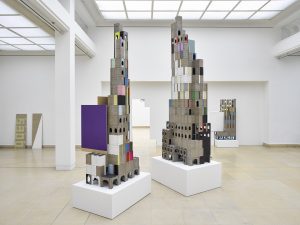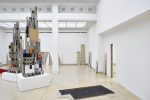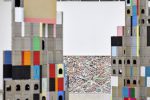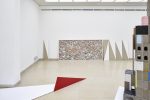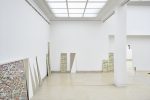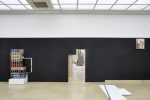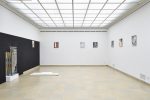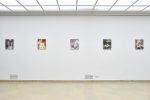Jackhammer & The Hole
Bernhard Brungs, Siggi Hofer
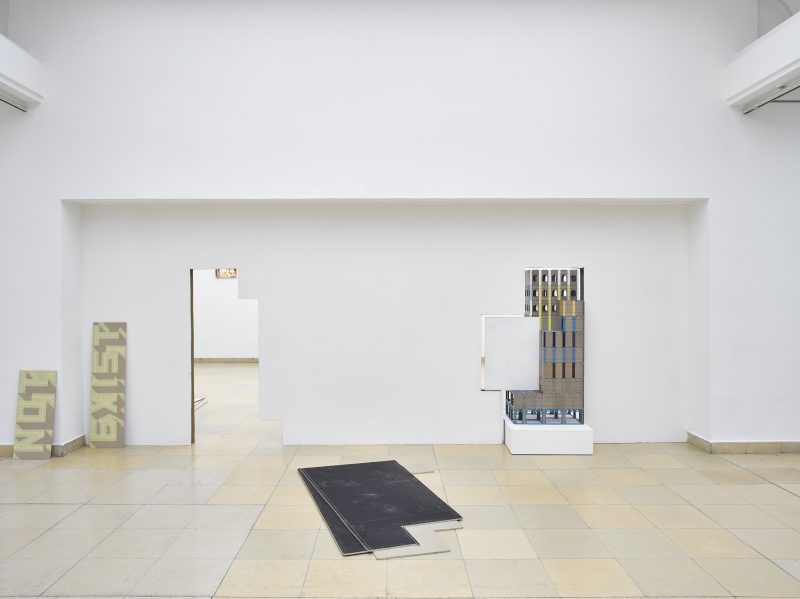
Artists Bernhard Brungs and Siggi Hofer have been friends for many years; each of them was fascinated by the entirely different working method of the other, and this inspired them to collaborate, which, after a year of intense work, culminated in the development of the current exhibition Jackhammer & The Hole in the Kunstpavillon, Innsbruck.
Entering the exhibition space, we encounter monumental objects on white pedestals, reminiscent of skyscrapers and early high-rise architecture in the USA, a large-format drawing of a cityscape leaning against the wall, and various fragments made from painted press-board panels, which are scattered loosely throughout the space. In the entrance area there is a cube-shaped monitor on the floor, showing a video that could be an (anti-)advertisement for a hazelnut spread. In the Kunstpavillon one can usually see right to the main wall at the back as soon as one enters, because of the wide corridor between the first and second room.
Siggi Hofer has closed this corridor with a wall, into which he cut two small openings with strange formats. People taller than 1.60m have to bend over to get into the next room, where nine small pictures by Bernhard Brungs – each measuring 50 x 40cm – are hanging on the walls, higher than is customary.
Anecdotes from the past, stories from a “far too narrow valley in the mountains of Southern Tyrol,” which Siggi Hofer told to Bernhard Brungs, were the starting point for this series of small-format paintings. Bernhard Brungs’s own memories are combined with his imagination of a place in a valley cut off from the outside world, which had been conveyed only through another’s memory and stories, to produce images suggestive of dream sequences in part. In the past Brungs created a number of work groups that started out from biographies, e.g. those of German-Jewish poet Else Lasker-Schüler, publicist Susan Sontag, fashion designer Yves Saint Laurent, or philosopher Ludwig Wittgenstein. The memories of other people form the basis to this process – in the knowledge that sometimes great effort has been put into the creation of myth. Anecdotal aspects in the biographies, and fictive encounters, i.e. a continued idea of reality, were already the foundation for many pictorial ideas at that time. Memory interests him as a fluid phenomenon. The focus is on the idea of a place – Ahrntal, where Siggi Hofer spent his childhood and youth, which Bernhard Brungs has never visited – that is cut off, links to the outside world so difficult that even the roof of the school bus had to be dented so that it could pass through the narrow entry into the valley. Combination with memories of his own, with interpretations of what has been told him, and other sources such as art-historical reminiscences, cause the images to move away from personal history and open doors to the viewers’ own associations. All the paintings of the work group have the same format and employ the same technique – painted in oil glaze on canvas, often applied in many layers on a chalk background. The difference lies in the works’ moods and stages of development, which are preceded by a time-consuming process of reworking, and various omissions. The unexplained spaces leave a great deal open, corresponding to the gaps in memory and its inherently selective perceptions. This means each of the paintings stands alone, as well, and they do not tell a story in the sequence.
The concept paper produced by the two artists about a year ago was entitled “It is an experiment”. The process of cooperation was not without friction, turning out to be more complicated than expected because different expectations and viewpoints clashed. This is reflected quite clearly in the spatial presentation by means of the two separated areas. This architectonic intervention divides the works by Siggi Hofer from those by Bernhard Brungs spatially, only to merge them again in terms of content. The smallest of the three tower sculptures stands in one of the openings, which was cut especially for it. The pedestal is on rollers, and so the object can be pushed between the two rooms. Siggi Hofer says that it is like a Trojan horse but with no “thought of conquest”, more like a gift that might be capable of creeping in through a creative act. The wall is painted white at the front and black at the back, and the sections removed for the openings, each in the other colour, are left lying on the floor. Despite the points of friction, there is exchange and movement here. Not everything is black and white.
Siggi Hofer’s towers and the large-format drawing were produced during or as the follow-up to longer stays in New York and Chicago in 2015, and so appear to reflect only the more recent past. He uses architecture, which is the subject of both the drawing and the towers, to sound out creative possibilities and reveal inadequacies. Restrictions to his working process from outside also play a part. Thus, the size of the drawing corresponds to that of the table in his Chicago studio, and the height of the tower objects resulted from the material’s limited availability. They are built from a greyish-brown toy construction system dating from the 1970s and symbolize the imagined hopes for the future of a still relatively dependent teenager. Reference to his childhood in the community of Ahrntal is more direct in the video work nutella, which Siggi Hofer describes as part of an emancipation process. It represents a late “revenge” on his aunt, with whom he grew up. Sparingly, she did no more than close the pores of the bread with the hazelnut cream – which seldom graced their table anyway –, in crass contrast to the plentiful spreading shown in the illustration on the product label. This is exaggeration as a form of coming to terms with the past. The monitor standing on the floor is embedded into a spatial presentation that is mobile and in which, by contrast to the classic panel picture, nothing is hanging on the walls. Everything is loose and – although carefully placed – open to change and development. The words that Siggi Hofer has written using sticky tape on five press-board planks, YOUR COUNTRY DOES NOT EXIST, also appear provisional or still in the process of evolving. Is this an appeal to his colleague Bernhard Brungs or to himself? It could also have something to do with the place in Southern Tyrol, or be directed critically against the occasionally science fiction-like architecture of US-American cities.
The title of the exhibition, Jackhammer & The Hole, also has several layers of meaning: it was borrowed from a gay bar of the same name in Chicago, which is divided into two parts like the exhibition space. But The Hole could also refer to the highly inaccessible valley in Southern Tyrol, which – at least in the imagination of the author, fed by oral tradition – is a “dead end”.
Ingeborg Erhart
